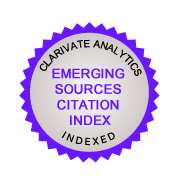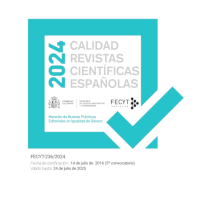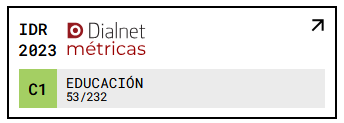Diversidad y geometría en la ESO : el caso de alumnado deficiente auditivo
DOI:
https://doi.org/10.18172/con.557Keywords:
Visualization, e-learning, deaf students, difference treatmentAbstract
The aim of the research conducted by the AUDIMAT Project since 2001, is to recognise and assess deaf students’ difficulties in regular inclusive classrooms to achieve their mathematics (geometry) learning with as similar results as hearing pairs. A module for e-learning is designed specifically for such purpose. We analyze the both reasoning from hearing - hearing impaired students in different periods in a regulation process for visualization and measurement activities.Downloads
References
Alsina, C., Burgués, C., y Fortuny, J. M. (1987). Invitación a la didáctica de la geometría. Madrid: Síntesis.
Balacheff, N. (2000). Entornos informáticos para la enseñanza de las matemáticas: complejidad didáctica y expectativas. En N. Gregorio, J. Deulofeu, J. y A. Bishop (eds.), Matemáticas y Educación: Retos y cambios desde una perspectiva internacional (pp. 70-88). Barcelona: Graó ICE-UB.
Barham, J., y Bishop, A. (1991). Mathematics and Deaf Child. En K. Durvin y B. Shire (eds.), Language in Mathematical Education: Research and Practice. Manchester. Open University Press.
Bellamy, R. K. E. (1996). Designing educational technology. En B. A. Nardi (ed.), Context and Consciousness. Cambridge, USA: MIT Press.
Carrasumada, C. (1995). Proceso de resolución de problemas aritméticos en alumnado sordo. Bellaterra: Universitat Autònoma de Barcelona.
Cobb, P., y Bauersfeld, H. (Eds.). (1995). The emergence of mathematical meaning: Interaction in classroom cultures. Mahwah, N.J.: Lawrence Erlbaum Associates.
Dreyfus, T., y Hadas, N. (1991). Stereometrix-A Learning Tool for geometry Visualization in Teaching and Learning Mathematics. En W. Zimmermann y S. Cunningham, Visualition in teaching and learning mathematics (pp. 87-94). Washington, USA: Mathematical Association of America.
Gillborn, D., y Gipps, C. (1996). Recent research on the achievement of ethnic minority pupils. Londres: HSMO.
Giménez, J. et al. (2002). Análisis de casos de construcción geométrica con ayuda hipermedia con alumnado deficiente auditivo. AUDIMAT. Informe de Investigación. Barcelona: Universidad de Barcelona. Recuperado de http://www.ub.es/div5/cinquena/pdf/telemat.pdf.
Gorgorió, N. et al. (1998). Exploring the functionality of visual and non-visual strategies in solving rotation problems. Educational Studies in Mathematics, 35, 207-231.
Jonassen, R., y Rohrer-Murphy, A. (1999). Activity theory as a framework for Designing Constructivist Learning Environments. ETRyD, 1(47), 41-79.
Kelly, R. R., y Mousley, K. (2001). Solving word problems: More than reading issues for deaf students. American Annals of the Deaf, 146, 251-262.
Kelly, R. R., Lang, H. G., Mousley, K., y Davis, S. (2003). Deaf college students' comprehension of relational statements in arithmetic compare problems. Journal of Deaf Studies and Deaf Education, 8(2), 120-132.
Kelly, R. R., Lang, H. G., y Pagliaro, C. M. (2003). Mathematics word problem solving for deaf students: a survey of perceptions and practices. Journal of Deaf Studies and Deaf Education, 8(2), 104-119.
Laborde, C. (2001). Integration of Technology in design of geometry task with Cabri geometry. International Journal of computers for Mathematical Learning, 6, 283-317.
Marchesi, A. (1978). El desarrollo de la representación espacial en el niño sordo. Mimeo. INCIE.
Mason, M. (1995). Geometric knowledge in a deaf classroom: An Exploratory Study. Focus on Learning Problems in Mathemathics, 17(3), 57-69.
Murillo, J. (2001). Un entorno interactivo de aprendizaje con Cabri-actividades aplicado a la enseñanza de la geometría en la ESO. Tesis Doctoral. Barcelona: Universitat Autonoma de Barcelona. Recuperado de http://www.tdx.cesca.es/TDX-0710101-030847/.
Noss, C., y Hoyles, C. (1996). Conexiones entre dominios matemáticos distintos: el caso de la geometría y el del álgebra. Proyecto de investigación Laboratorio Leibniz del IMAG (Instituto de Matemáticas Aplicadas de Grenoble).
Pleiss, L. (1998). A "Hole in one" for Communication: Geometry Project Lines Up Math Skills and Hearing/Deaf Cooperation. Perspectives in Education and Deafness, 17, 6-9.
Rosich, N. (1995). Los niveles de pensamiento geométrico y la resolución de problemas geométricos con alumnos sordos y oyentes: implicaciones pedagógicas. Tesis doctoral. Barcelona: Universidad de Barcelona.
Rosich, N., y Serrano, C. (1998). Las adquisiciones escolares: aprendizaje en matemàticas. En N. Silvestre (coord.), Sordera. Comunicación y aprendizaje (pp. 133-141). Barcelona: Mason.
--- (2002). L’alumnat sord a l’etapa primària: les matemàtiques. En N. Silvestre et al., L’alumnat sord a les etapes infantil i primària. Criteris i exemples d’intervenció educativa. Barcelona: UAB.
Silvestre, N. et al. (1998). Sordera. Comunicación y aprendizaje. Barcelona: Mason.
Suppes, P. (1974). A Survey of Cognition in Handicapped Children. Review of Educational Research, 44(2), 145-176.
Wenger, E. (2001). Comunidades en práctica. Barcelona: Paidós. Recuperado de http://www.co-I-l.com/coil/knowledge-garden/cop/lss.html.
Wood, T. (2001). Learning to teach Mathematics differently: Reflection matters. En Proceedings 25th PME. Utrecht, IV (pp. 431-438).
Wood, D. (1983a). El desarrollo lingüístico y cognitivo en la deficiencia auditiva. Infancia y Aprendizaje, monográfico, 6(Monografía 3), 201-222.
Wood, D., Wood, H., y Howarth, L. (1983b). Language, Deafness and Mathematical Reasoning. En Rogers, D. R. Sloboda y J. A. Sloboda (eds.), The Adquisition of Symbolic Skills (pp. 233-239). New York: Plenum Press.
Wood, D. et al. (1984). The Mathematical Achievement of Deaf Children from Different Educational Environments. British Journal of Developmental Psychology, 54, 254-264.
Zack, V., y Graves, B. (2001). Making mathematical meaning through dialogue: once you think of it, the z minus three seems pretty weird. Educational Studies in Matehematics, 46, 229-271.
Downloads
Published
How to Cite
Issue
Section
License
The authors retain copyright of articles and authorize Contextos Educativos. Revista de Educación the first publication. They are free to share and redistribute the article without obtaining permission from the publisher as long as they give appropriate credit to the editor and the journal.
Self-archiving is allowed too. In fact, it is recommendable to deposit a PDF version of the paper in academic and/or institutional repositories.












